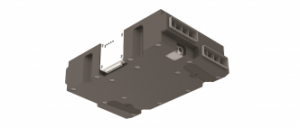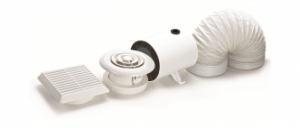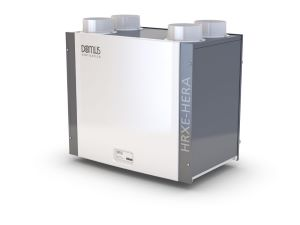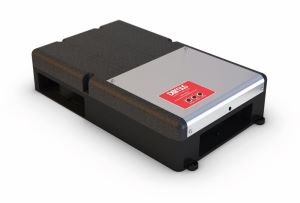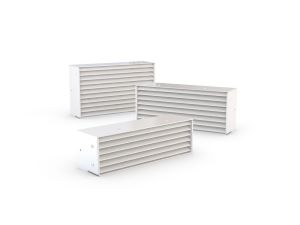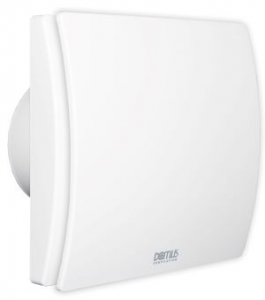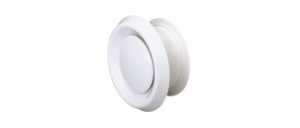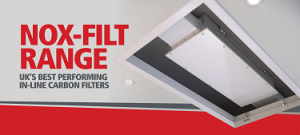DOMUS VENTILATION
Suppliers of: Ventilation Ducting Ventilation Ducts Extractor Fans Bathroom Fans Kitchen Fans MVHR Mechanical Ventilation Heat Recovery MEV Mechanical Extract Ventilation
Domus Ventilation is a manufacturer of market-leading ventilation systems that save energy and improve indoor air quality. Established over 30 years ago, and now part of the Genuit Group, Domus Ventilation manufactures high quality and solution based ventilation products for the domestic and light commercial building industry from its state-of-the-art production facilities in South Wales. The company provides differentiated ventilation solutions, transforming the way developers, contractors, installers, home owners and distributors meet Building Regulations Parts F & L and emerging environmental standards.
Useful Resources:
- BIM available: Click here
Main Product Ranges:
Fan Range:
The range includes award winning, high performing and energy efficient mechanical extract ventilation appliances and fans that are suitable for a wide variety of domestic applications and dwelling sizes.
Mechanical Ventilation with Heat Recovery (MVHR):
- Ideal for new build
- Continuous supply and extract ventilation incorporating heat recovery – for whole house applications
Mechanical Extract Ventilation (MEV):
- System 3 in Approved Document F of the Building Regulations
- Centralised ventilation unit that continuously extracts waste air
Decentralised Mechanical Extract Ventilation (dMEV):
- System 3 in Approved Document F of the Building Regulations
- dMEV fans continuously extract the waste air at both low trickle or boost speeds
In-Line / Axial / Centrifugal Extract Fans:
- Domus Extract fans remove condensation and moist air and include options ideal for new build and refurbishment applications
- NEW to the range are Sapphire fans – Designed to complement internal decor with extremely quiet performance.
House Packs:
- Suitable for multi-floor, single-floor and apartment configurations
- Over-the-counter full ventilation system
Fan Ancillaries & Controls:
Domus has a wide range of Accessories and Controls to use with our vast rage of ventilation solutions. These include:
- Extract Fan fitting & Fixing kits
- Extract Fan Control Options
- MVHR Accessories / Filters / Duct Kits
- Condensation Drain Kits
- MEV Air Supply
- Sapphire Fan Fascia
- Spotvent Ceiling Light Grille
Domus Ducting:
Our range of Domus ducting offers a high quality solution for domestic & commercial applications.
- Ducting Kits
- Rectangular / Round / Thermal Ducting
- Flexible / Semi-Rigid / Acoustic Ducting
- Internal / External Grilles
- Fire Prevention Solutions
- Domus Adapt / Domus Radial Ducting Systems
Further Technical information is available to download from the BPi download library or from the Manufacturer’s own website.
Domus Ventilation 6 reasons you should be using MVHR systems
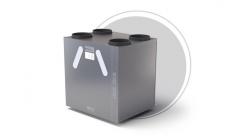 Valued at $106.69 million in 2022, the Mechanical Ventilation Heat Recovery (MVHR) UK market is predicted to reach $235.34 million by 2030, with an annual growth rate of 10.73% from 2024 to 20301. This extraordinary growth is being driven by increased awareness about the benefits of MVHR, as well as the adoption of these systems to comply with the latest uplift to Building Regulations.
Valued at $106.69 million in 2022, the Mechanical Ventilation Heat Recovery (MVHR) UK market is predicted to reach $235.34 million by 2030, with an annual growth rate of 10.73% from 2024 to 20301. This extraordinary growth is being driven by increased awareness about the benefits of MVHR, as well as the adoption of these systems to comply with the latest uplift to Building Regulations.
MVHR systems take a whole house approach to ventilation, combing supply and extract ventilation in one system. They extract the stale air from wet rooms (kitchens, bathrooms, utility spaces) within a property via ducting, transferring the heat from that air to the fresh air being drawn into the building via a heat exchanger. Domus Ventilation’s HRXE MVHR range recovers heat with up to 95% efficiency, making it highly effective. The filtered, pre-warmed air is then distributed around the home.
MVHR systems are a modern response to modern building practices. With properties becoming more air tight and energy efficient, it’s vital that good ventilation is designed into properties at the outset. Opening a window or two isn’t going to deliver indoor air that is healthy to breath and comfortable to live in.
If you are not one of the many people driving the growth of MVHR systems, and are yet to be sold on these ventilation systems, then consider these key benefits:
Health
In the UK, we’re not an outdoors type of nation. In fact, we spend 80-90% of our time indoors. The air that we breath indoors is therefore just as – if not more – important than the air we breathe outdoors, yet indoor air pollution can be up to five times higher than external air pollution. Sources of indoor air pollution are widespread and vary dramatically from house to house, but include cooking, cleaning products, furniture and outdoor emissions entering our homes. Then, of course, you have condensation and, in worst case scenarios, mould to contend with in the winter months.
Poor indoor air quality has been linked to an increased risk of respiratory and cardiovascular illness, cognitive impairment and certain cancers. England’s Chief Medical Officers Annual Report 2022 Air Pollution stated: “A better understanding of how we can prevent and reduce indoor air pollution should now be a priority”. It also noted “The role of ventilation is central to reducing unavoidable indoor air pollution.” MVHR systems are the most effective ventilation method for our homes as they both extract stale air and supply filtered ‘fresh’ air to key rooms, such as bedrooms.
Comfort
Breathing in poor quality air is not only unhealthy, it’s unpleasant. As stale air is usually the result of a buildup of chemicals (especially VOCs) and humidity, our homes feel ‘stuffy’ and can have an unpleasant smell. Ironically, using an air freshener to combat this simply adds to the chemical concoction. MVHR systems are continuously on, removing that stale, humid air and its undesirable odours. Furthermore, during colder months they take the chill out of the supply air by passing it through a heat exchanger where the outgoing air’s energy is extracted and transferred. In the summer months, a 100% thermal bypass automatically activates when the air temperature reaches a pre-set level, allowing in cooler, fresh, filtered air without warming it through the heat exchanger.
Energy efficiency
By reusing the outgoing air’s heat to temper the incoming air, MVHR systems help reduce the home’s heating load. The Centre for Sustainable Energy estimates heating costs can be reduced by around 25% 2. Whilst MVHR running costs are dependent on the property size, building fabric, occupant lifestyle etc., they are inexpensive to run. To ensure maximum energy efficiency is gained from an MVHR system though, it’s important to correctly size the unit, use good quality ducting designed to work as part of that system (Domus Ventilation ducting has been third party tested for end-to-end system performance), and correctly installed and commissioned.
Structural integrity
Whilst VOCs are unlikely to impact a building’s structure, persistent damp and mould can. If not dealt with, trapped condensation can lead to timber decay and can have a detrimental effect on insulation. More often though, it leads to mould growth on surfaces of walls and furniture. Removing large areas of mould is not easy and can be costly, especially when redecorating is required and furniture has to be replaced. What’s more, as the source of the mould hasn’t been addressed, it’s very likely it will return. MVHR systems not only remove pollutants from homes, but also the humidity, reducing levels of condensation and preventing mould from forming.
Value-add
Thanks to campaign groups, scientists and health professionals raising awareness, along with some high profile tragic cases where two children have died – one from air pollution and the other from mould in his home – the general public are more aware than ever before of the importance of good air quality. Stories of extreme overheating in properties located in urban heat islands are also making national news. For housebuilders, an MVHR system can therefore be an attractive proposition to home buyers, providing them with good indoor air quality, added comfort and energy efficiency.
These six points all provide a powerful argument for including MVHR systems into your new residential developments. So, if you haven’t really considered MVHR systems previously, isn’t it time to think again?
1 UK Mechanical Ventilation Heat Recovery (MVHR) Market size published February 2024 by Verified Market Research
2 https://www.cse.org.uk/advice/mechanical-ventilation-with-heat-recovery/
Domus Ventilation Expands Energy Efficient Axial Fan Range
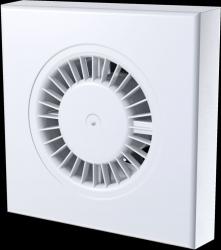 UK ventilation manufacturer Domus Ventilation has added new models to its intermittent axial fan range: the DBF100 100mm (4”) fan and the DKF150 150mm (6”) fan. Both fan types are available in versions with timer control, and combined humidistat and timer control which identifies and reacts to a significant change in humidity. The DBF100 is also available with a pull cord control.
UK ventilation manufacturer Domus Ventilation has added new models to its intermittent axial fan range: the DBF100 100mm (4”) fan and the DKF150 150mm (6”) fan. Both fan types are available in versions with timer control, and combined humidistat and timer control which identifies and reacts to a significant change in humidity. The DBF100 is also available with a pull cord control.
The new Domus Ventilation axial fans have been designed for high performance and energy efficiency. The DKF150 provides extract volume rates up to 48.8 l/s, with the smaller DBF100 operating up to 18.6 l/s, ensuring compliance with Building Regulations Part F Ventilation. Even with these high extraction rates, the new fans operate with a low Specific Fan Power (SFP), down to 0.38W/l/s, saving energy and reducing operating costs. They are also quiet in operation, down to 34dB(A).
As with all Domus Ventilation products, ease of installation has been a fundamental aspect of the product design. The new axial fans are compact so readily fit into small spaces. They come with easy-to-follow installation instructions and flexible mounting options, and compatible ducting kits are available to order.
Built with high-quality materials and durable components, the new fans are robust and provide long-lasting, reliable performance, whilst also being positioned at an extremely attractive price point, representing genuine value for money. They come with a two year warranty as standard.
Designed to work with short duct runs which connect directly to an external outlet or grille, the Domus Ventilation axial fans are suitable for use in residential and light commercial bathrooms, toilets, kitchens, and utility rooms. They have an aesthetically pleasing design that is both discreet and contemporary, making them suitable for all interior design styles.
The addition of the DBF100 100mm (4”) and DKF150 150mm (6”) fans now complete the Domus Ventilation axial fan range, providing customers with a single source of axial fans.
Domus Ventilation has a well-deserved reputation for quality, supported by excellent technical support, from a market leading manufacturer and designer. It is well placed to offer immediate, practical solutions to Building Regulations Parts F & L. For further information, please contact vent.info@domusventilation.co.uk or visit domusventilation.co.uk



